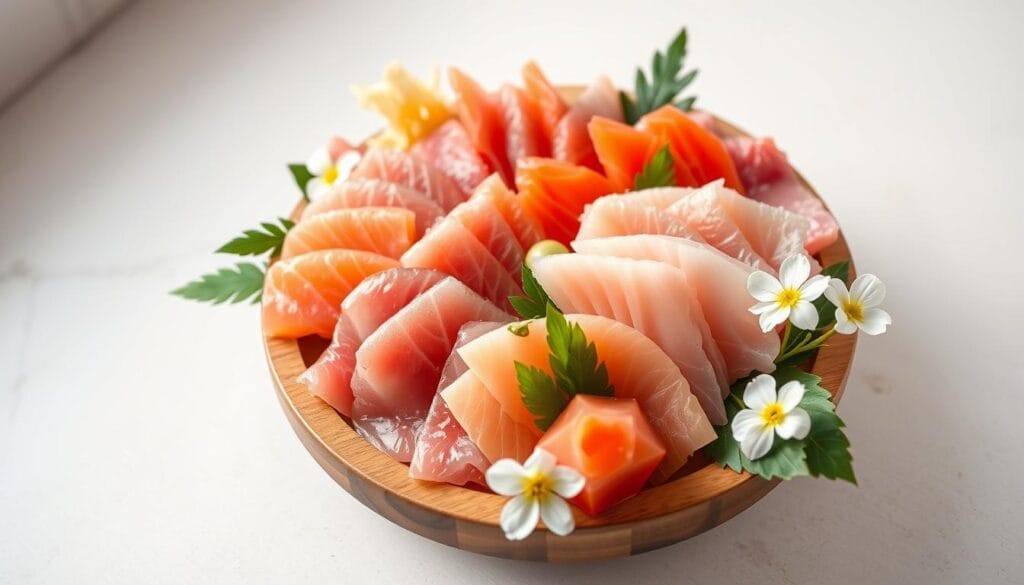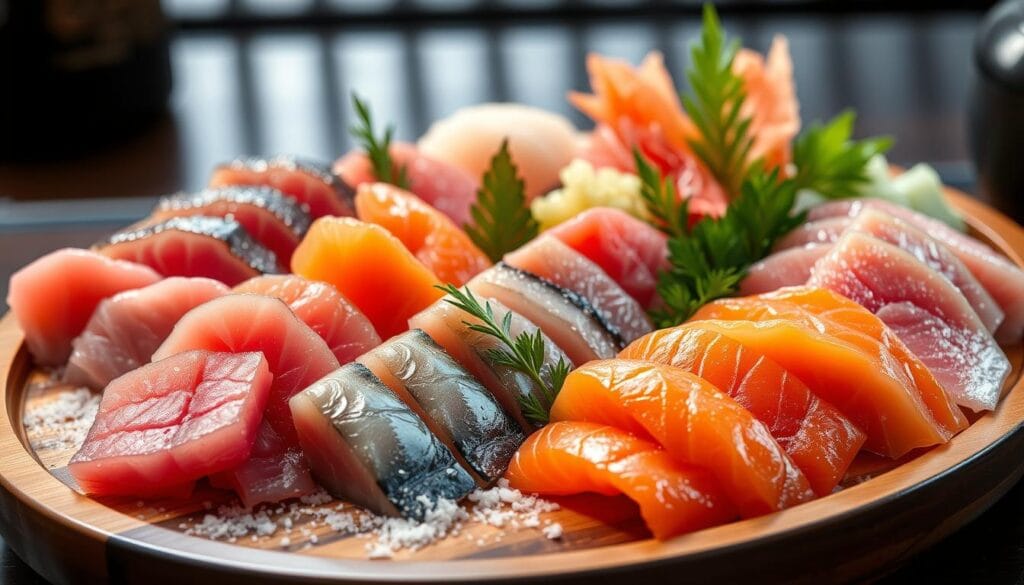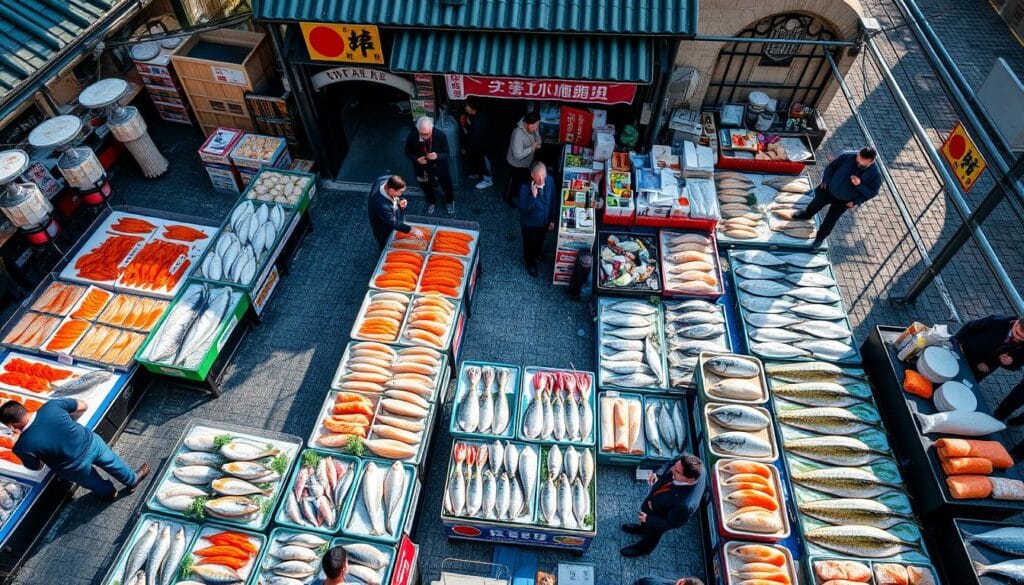Ever wondered, Why Is Sashimi So Expensive? It’s because of the fish quality and the chef’s skill. Sashimi’s price is complex, but knowing what makes it pricey can make it more valuable.
Luxury foods like caviar can cost from $1,500 to $10,000 per kilogram. The sushi market has grown to 700 billion yen by 2021. This demand for top-notch sashimi drives up its price. Exploring sashimi reveals that its cost is worth it for the quality, chef’s artistry, and cultural importance.
Understanding Sashimi: A Premium Japanese Delicacy
Sashimi is a top-notch Japanese dish that needs the best ingredients and careful making. Its cultural value in Japanese food also adds to its cost. Expect to pay more for luxury sashimi prices because of the high price of fresh, sustainable fish.
The sushi grade fish prices change based on the fish type and quality. Fish like salmon, tuna, and yellowtail are often used. The gourmet sashimi cost also depends on how it’s presented and served. High-end places offer a special dining experience.

- High-quality ingredients
- Careful preparation and presentation
- Cultural significance and exclusivity
- Restaurant markup and operating expenses
The price of sashimi varies for many reasons. These include the fish type and quality, presentation, and service. Also, the restaurant’s costs play a part. But for those who love sashimi’s unique taste and texture, it’s worth the price.
| Restaurant | Sashimi Price |
|---|---|
| Sushi Nakazawa | $190 |
| Sushi 35 West | $120 |
| Nami Nori | $32 |
The Critical Role of Fish Quality and Grade
The quality and grade of fish are key when it comes to sashimi prices. Fish like bluefin tuna and beluga sturgeon are very expensive. They are sought after for their unique taste and texture.
These fish are caught using special methods. They are considered the best quality.
The grade of the fish also affects the price. Costly sashimi ingredients like these are used in fancy restaurants. The freshness, fat content, and any defects are important for the grade.
Here are some key factors that influence the quality and grade of sashimi fish:
- Freshness: Fresh fish is essential for sashimi, as it ensures the best flavor and texture.
- Fat content: Fish with high fat content, such as bluefin tuna, are often more expensive and prized for their rich flavor.
- Defects: Fish with defects, such as scars or bruises, are often downgraded and sold at a lower price.

In conclusion, the quality and grade of the fish are critical factors that influence the price of sashimi. Factors influencing sashimi prices include the freshness, fat content, and the presence of any defects. By understanding these factors, you can appreciate the value of high-quality sashimi and the costly sashimi ingredients that go into creating this unique dining experience.
| Fish Type | Grade | Price |
|---|---|---|
| Bluefin Tuna | High | $200-$300 per pound |
| Beluga Sturgeon | High | $150-$250 per pound |
| Salmon | Medium | $10-$20 per pound |
Sourcing and Transportation Costs
High-quality fish is key to sashimi. The cost of sashimi varies based on the fish type, origin, and transport methods. Understanding the sourcing and transport of sashimi-grade fish helps explain its price.
Fish must be caught, processed, and transported quickly to stay fresh. This process needs special equipment and skills, increasing sashimi costs. For example, Fulton Fish Market in New York offers free shipping on orders over $125. Rastelli’s provides a wide range of seafood, beef, chicken, and pork.
International Shipping Requirements
Shipping sashimi internationally is complex and costly. Fish must be kept fresh during transport. LobsterAnywhere ships hard-shelled lobsters from Maine, with prices changing based on market conditions.
Temperature Control Standards
Keeping sashimi-grade fish at the right temperature is vital. This requires special equipment and handling, adding to the cost. It’s essential for preventing spoilage and maintaining quality.
Supply Chain Complexity
The sashimi supply chain is complex, with many intermediaries. This complexity increases costs. Wild Alaskan Company specializes in salmon subscriptions, simplifying the supply chain and reducing costs.

Understanding the sashimi market and its costs requires examining the entire supply chain. Various factors contribute to the premium price of sashimi.
| Company | Product | Price |
|---|---|---|
| Fulton Fish Market | Frozen Fish | $125+ |
| Rastelli’s | Seafood, Beef, Chicken, Pork | Varies |
| LobsterAnywhere | Hard-shelled Lobsters | Market price |
| Wild Alaskan Company | Salmon Subscriptions | Varies |
Why is Sashimi So Expensive? Breaking Down the Costs
When you think about is sashimi healthier than sushi?, it’s key to know what makes it pricey. The cost of sashimi comes from several parts. These include the raw materials, the skill needed to prepare it, and how it’s stored and handled.
The type and quality of the fish greatly affect sashimi’s price. For instance, tuna sashimi has different cuts with varying prices. How much sashimi for 1 person can change a lot based on the fish type and quality. Some popular sashimi types include:
- Salmon: reasonably priced and widely available
- Red snapper: considered a delicacy and often more expensive
- Yellowtail: affordable and packed with vitamins and minerals
Another factor is the cost of labor and expertise. Making and serving sashimi needs special skills and knowledge. This adds to the price.
Storage and handling also impact sashimi’s cost. The fish must be kept fresh and of high quality. This requires careful storage and handling, increasing the expense.
| Type of Sashimi | Price Range |
|---|---|
| Tuna | $10-$30 per piece |
| Salmon | $8-$20 per piece |
| Red Snapper | $15-$40 per piece |
The Art of Sashimi Preparation
Preparing sashimi is an art that needs special skills and knowledge. You might ask what is the most expensive type of sashimi. The answer often depends on the fish’s quality and rarity. Chefs must pick the freshest, highest-quality fish to highlight its unique taste and texture.
The sashimi preparation process is detailed. Each fish piece is sliced carefully to improve its texture and taste. The chef’s knife skills are key, as they need to cut the fish into thin, even slices. Some favorite sashimi types include:
- Bluefin tuna, known for its rich, buttery flavor
- Salmon, with its delicate flavor and firm texture
- Yellowtail, a popular choice for its sweet flavor and tender texture
Not just the fish’s quality matters, but also the chef’s knowledge of it. They must handle and prepare the fish safely while highlighting its unique taste and texture. Sashimi is a true culinary art, with its delicate flavors and textures. This makes what is the most expensive type of sashimi a question that sparks curiosity and interest in this traditional Japanese dish.
Market Dynamics and Seasonal Factors
When you ask is it ok to eat a lot of sashimi?, it’s key to know the market and seasonal factors. These affect sashimi’s price and how easy it is to find. Demand for sashimi changes with the seasons, making prices go up during busy times.
The lifespan of sashimi is also tied to these factors. Freshness and quality are vital for sashimi. Things like fishing rules, when fish are in season, and demand changes all play a part in sashimi’s high cost.
Some important stats show how market dynamics affect sashimi:
- Global farmed salmon production was about 2.2 million tons in 2023, making up two-thirds of all salmon.
- Norway sold salmon worth NOK 122.9 billion in 2024, which is 70% of their seafood exports.
- The price of fresh salmon fillets hit a record high in 2024, at NOK 149 per kg.
Knowing about these market and seasonal factors helps you understand sashimi better. It lets you enjoy this Japanese delicacy more.
| Country | Salmon Consumption (2023) | Year-on-Year Increase |
|---|---|---|
| China | 108,128 tons | 43% |
| Norway | 2.2 million tons (global farmed salmon production) | N/A |
Premium Varieties and Their Price Points
Premium fish varieties can be quite pricey. This is because of their unique taste and texture. Bluefin tuna and rare fish are top choices for their delicate flavor and firm texture.
The cost of gourmet sashimi varies. It depends on the fish type, quality, and market demand. For instance, Ahi Tuna Sashimi costs between $19.75. Teriyaki Glazed Salmon can cost between $19.50 and $23.75.
Here are some popular premium fish and their prices:
- Bluefin Tuna: $50-$100 per piece
- Rare Fish Species: $30-$70 per piece
- Regional Specialties: $20-$50 per piece
The price of luxury sashimi can change with the season. But, for those who splurge, it’s a memorable experience.
Safety Standards and Certification Costs
When it comes to sashimi, safety standards are key. The cost of keeping fish safe affects sashimi prices. Chefs need special training and gear, making sashimi more expensive.
The certification process is complex and pricey. It adds to sashimi’s high cost. Key factors include:
- Regular inspections to ensure compliance with food safety regulations
- Training and certification for chefs and handlers
- Investment in specialized equipment and storage facilities
These costs ensure sashimi is both quality and safe. Remember, safety and certification are big parts of sashimi’s price.
Understanding safety and certification costs shows the value of sashimi. The mix of expensive ingredients, expert skills, and strict safety rules raises the price of this dish.
| Factor | Description | Cost Impact |
|---|---|---|
| Safety inspections | Regular inspections to ensure compliance with food safety regulations | High |
| Chef certification | Training and certification for chefs and handlers | Medium |
| Equipment and storage | Investment in specialized equipment and storage facilities | High |
Restaurant Markup and Operating Expenses
When you order sashimi at a restaurant, the price you pay is more than just the fish cost. Restaurant markup and operating expenses greatly affect the final price. On average, restaurants mark up ingredients by 200% to 400% of their wholesale cost. So, if a restaurant pays $10 for fish, they might charge you $20 to $40.
The high price of sashimi comes from skilled chefs, special equipment, and storage needs. These costs are part of the sashimi market trends. High-end restaurants charge more for their dishes. So, why does sashimi cost more? It’s because of these factors, which increase the cost of serving top-quality sashimi.
Here are some key expenses that make sashimi pricey:
- Skilled chef requirements: Hiring experienced chefs is a big expense.
- Equipment and storage investments: Restaurants spend on special gear and storage to keep fish fresh and safe.
- Waste management considerations: Restaurants also pay for waste disposal and keeping a clean environment.
In conclusion, sashimi prices are influenced by many factors, including restaurant markup and operating costs. Understanding these factors helps us value the quality and skill that goes into making sashimi.
| Factor | Contribution to Price |
|---|---|
| Skilled chef requirements | 20-30% |
| Equipment and storage investments | 15-25% |
| Waste management considerations | 5-10% |
Conclusion: Is the High Price of Sashimi Justified?
The price of sashimi is high, but it’s worth it. This Japanese dish is special because of its unique qualities and cultural importance. The careful preparation and high-quality ingredients add to the cost.
While some might find it too expensive, others see it as a chance to enjoy something truly unique. Sashimi offers flavors and artistry that are hard to find elsewhere.
The journey of sashimi fish from sea to plate is long and costly. Sushi chefs’ skills and the need for precise handling also increase the price. Yet, for those who love sashimi, the taste and cultural value are worth the cost.
Frequently Asked Questions (FAQs)
1. Why does sashimi cost more?
Sashimi typically costs more than other fish dishes because it requires the highest-quality, freshest fish, along with specialized preparation techniques. Chefs must invest significant time honing their knife skills to produce perfectly sliced, visually appealing pieces. The emphasis on premium ingredients and expert craftsmanship drives up the price.
2. Is sashimi healthier than sushi?
Sashimi can be considered healthier than sushi for some people because it consists solely of fresh raw fish without any rice or additional seasoning. This generally means fewer carbohydrates and potentially fewer calories. However, it still depends on factors like portion size and the type of fish.
3. How much sashimi for 1 person?
The recommended serving size can vary, but a good guideline is around 4 to 6 ounces (approximately 113 to 170 grams) of fish per person. Adjust the amount based on individual preferences and whether other dishes are being served.
4. What is the most expensive type of sashimi?
Some of the most expensive sashimi comes from high-grade Bluefin tuna, especially the fatty belly cut known as otoro. This particular cut is prized for its rich, buttery texture and rarity, making it one of the costliest options on the menu.
5. Is it OK to eat a lot of sashimi?
Eating sashimi in moderation is generally safe if it’s sourced from reputable vendors who follow proper handling and storage procedures. However, excessive consumption of certain fish (like tuna) may increase exposure to mercury. Always be mindful of quality and variety to minimize risk.
6. What is the lifespan of sashimi?
Sashimi is best consumed as fresh as possible—ideally on the same day it’s prepared. In many cases, it’s recommended to eat sashimi within 24 hours, provided it has been stored correctly at the proper temperature. Proper handling and refrigeration are crucial to ensuring the best flavor and safety.
